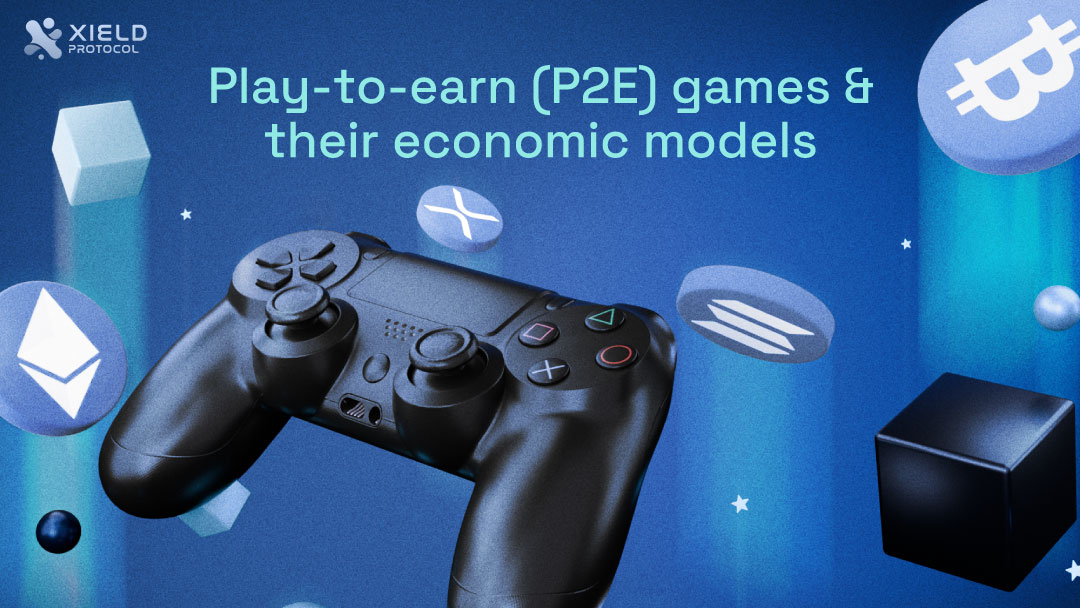Gaming has undergone tremendous transformation in recent years as a result of the Play-to-Earn (P2E) economic model. The play-to-earn concept has transformed the gaming business by offering users a new option to make money while playing their favorite games. P2E gaming has enormous potential to further affect the gaming business, and it is becoming increasingly popular.
This new wave, defined by decentralized gaming and the “play-to-earn” economy, is profoundly changing how users engage with games, own in-game assets, and, perhaps, earn a living. Buckle up, because we’re about to explore the thrilling world of Web3 gaming economics!
The Rise of Play-to-Earn Games: Own Your Digital Sweet
Traditional gaming frequently relies on acquiring in-game things that are worth only within the game’s ecology. Blockchain upsets this by introducing the concept of play-to-earn, in which players can buy in-game assets using cryptocurrencies or non-fungible tokens (NFTs). These assets have real-world value and may be traded on decentralized platforms.
For example, Axie Infinity, a popular play-to-earn game, allows users to collect, breed, and battle adorable creatures known as Axies. These Axies are NFTs, which means that players have legitimate ownership and can sell them on the open market for real money. This concept motivates participants by converting their time and effort into measurable rewards.
How does play-to-Earn transform the gaming industry?
The P2E business model employs blockchain technology to provide secure and transparent tracking of in-game assets and rewards. This is how it works.
In-game Tokenomics
In-game tokenomics is at the heart of the P2E paradigm. Participating in gameplay allows players to earn tokens, or NFTs. These assets have real-world worth and can be bought or sold.
Democratizing Income Streams
P2E gaming democratizes income streams by allowing players of all skill levels to make money. Unlike traditional gaming, which frequently needs specialized skills or professional status, play-to-earn platforms enable anybody who is enthusiastic about gaming to monetize their participation and efforts, making revenue options more accessible and inclusive.
Deeper Player Engagement
The idea of earning real money while playing encourages people to engage more deeply with games. This model benefits both gamers and developers.
The Play-to-Earn gaming business is predicted to grow to $8,856.95 million by 2028. The increased demand for decentralized finance (DeFi) applications, which let gamers participate in a financial ecosystem within the game, is driving this growth.
Furthermore, the use of blockchain technology has contributed to this expansion. P2E is gaining traction as blockchain technology becomes more widely adopted. Key features include secure asset tracking and transparent ownership.
Finally, there are non-fungible tokens (NFTs). NFTs are crucial to the P2E paradigm because of their uniqueness and rarity, which make them valuable collectibles in games.
The Evolution of Gaming Economics
Traditionally, gaming has been a one-way financial transaction: gamers pay for games, in-game stuff, and subscriptions with no expectation of a return. However, the advent of blockchain technology has upended this paradigm. Blockchain enabled the introduction of non-fungible tokens (NFTs) and digital assets, allowing for the actual ownership, scarcity, and transferability of in-game objects and characters.
P2E models allow players to earn tokens or cryptocurrencies by engaging in games, meeting milestones, or selling digital assets. These tokens can then be swapped for fiat currency, making gaming a potential source of income. This move has democratized the gaming business, allowing individuals of all backgrounds to profit monetarily from their gaming abilities and time.
Economics of Play-to-Earn Games
Tokenomics
Token Generation
In most P2E games, tokens are generated by player interactions. These activities can include completing quests, battling conflicts, and even passive behaviors like farming or mining. To ensure a healthy economy, game developers frequently fine-tune the rate of token generation.
Token Utility
Tokens in play-to-earn games can serve numerous uses. They can be used as a medium of exchange for in-game products and services, a marker of a player’s status or achievement, or even as a governance token that enables users to participate in decision-making processes affecting the game.
Token Value
Scarcity, utility, and demand all influence the value of tokens in P2E games. A token’s value tends to rise when it is difficult to obtain, has various applications, and is in great demand.
Token Trade
P2E games enable players to trade tokens with one another, resulting in a player-driven economy. Some games even include built-in marketplaces to facilitate these transactions. The ability to swap tokens for real-world money on external exchanges is a distinguishing characteristic of P2P games.
NFT and Asset Ownership
Digital Ownership
Non-fungible Tokens (NFTs) allow players to own in-game assets like characters, goods, skins, and land. These NFTs are unique digital assets kept on the blockchain. that provide participants with verified ownership. Unlike traditional in-game assets, NFTs may be traded, sold, or rented on a variety of decentralized markets, allowing players to monetize their collections and investments and fostering a genuine sense of ownership and worth.
Rarity and value
NFTs’ worth is frequently determined by their scarcity, distinctiveness, and utility within the game. Rare and highly sought-after objects can increase in value over time, resulting in possible gains for gamers.
Earning Mechanisms
Play-to-Earn
Players can earn in-game tokens, or NFTs by completing tasks, winning fights, and reaching goals. These digital assets may be bought or sold on exchanges for fiat funds, allowing gamers to turn their gaming efforts into real-world earnings.
Staking and Yield Farming
Some P2E games have staking options, allowing users to lock their tokens or NFTs within the game’s environment. In exchange, they get passive income or other incentives, like interest or bonus tokens, to encourage long-term engagement.
Marketplace Trading
Players can actively exchange NFTs and tokens on open marketplaces. Players may profit from market volatility and the scarcity of in-game assets by deliberately purchasing low and selling high, much like in stock or cryptocurrency trading.
Game Economy and Player Incentives
Circular Economy
A circular economy in a well-structured Web3 game guarantees that tokens and assets move continuously among players, developers, and the ecosystem. Players use tokens to make in-game purchases, which helps with game development and prizes. This approach generates a self-sustaining cycle in which player spending and game income support one another.
Incentive structures
To increase user engagement and retention, developers frequently use various incentive systems, such as daily incentives, competitive tournaments, and seasonal events. These incentives not only keep players engaged but also increase their involvement in the game.
Burning Mechanisms
To protect token value, several games use token-burning tactics, in which a percentage of tokens are permanently withdrawn from circulation. This decrease in supply can help enhance the value of the remaining tokens, so preserving economic stability.
Sustainability Challenges
Inflation and Token Values
Excessive token issues without proper supervision can result in inflation, lowering the token’s value, and reducing player revenues. As tokens grow more plentiful, their purchase power decreases, affecting the economic incentives for participants.
Player Base Growth
P2E gaming platforms rely largely on a rising player population to be financially stable. A standstill or reduction in player numbers might result in lower demand for tokens and NFTs, disrupting the game’s economy and lowering the total value of in-game assets.
Regulatory Risks
The presence of real money and cryptocurrencies in P2E games makes them subject to regulatory scrutiny. Changes to rules or compliance requirements may have an impact on the game’s functioning, token value, and overall financial sustainability.
Social and community dynamics
Guilds and Community
Guilds and communities are important in P2E games because they pool resources and methods to increase overall revenue. Guilds frequently act as companies, providing scholarships to new players who lack starting resources in return for a percentage of their revenue. This promotes growth and establishes a structured atmosphere for maximum earnings.
Collaborative and Competitive Play
The economic model encourages competitive and collaborative gameplay. PvP battles with rewards motivate rivalry, but cooperative missions and challenges stimulate collaboration. This dual focus increases player engagement and involvement, which drives the overall dynamic and sustainability of the game’s economy.
Future Trends
Interoperability
As the P2E ecosystem matures, interoperability is projected to become an important trend. This implies that assets and tokens from one game may be used or exchanged in another, increasing their value and utility across different platforms and resulting in a more consistent gaming experience.
Decentralized Game Development
Some DeFi games may evolve into decentralized autonomous organizations (DAOs). In these approaches, the community has significant authority over the game’s development and economic decisions, which promotes a more democratic and player-driven approach to game administration.
Integration into the Metaverse
P2E games are expected to become key components of the metaverse, linking their in-game economy to larger digital worlds. This connection might increase the value of digital goods and open up new opportunities for participants in a huge virtual ecosystem.
Impact on the Broader Gaming Industry and the Global Economy
The play-to-earn (P2E) concept has had a considerable impact on traditional gaming models. It creates a new dynamic in which value flows in both directions, rather than just from players to game makers.
This has resulted in a shift in the gaming industry’s economic structure, affecting job possibilities, investment, and technological advancement. The P2E model has spawned a new ecosystem of occupations, ranging from professional players to digital asset traders, and has attracted major investment, accelerating technological progress in the gaming sector.
The P2E concept has wide-ranging gamifications for the global economy. Web3 gaming platforms create economic activity that contributes to the Gross Domestic Product (GDP) of countries, especially in locations where digital economies are thriving. GDP is the total worth of goods produced and services provided in a country in a given year, and it serves as a comprehensive assessment of the country’s overall economic activity.
The emergence of P2E models may also result in changes to laws as governments aim to better comprehend and regulate these new economic systems.
Closing Thoughts
The Play-to-Earn is shaking up the gaming industry by offering a new economic framework that benefits both gamers and developers. By utilizing blockchain technology, it offers a secure and transparent platform for users to earn real-world money from their gaming actions. Although P2E games confront obstacles such as market volatility, regulatory uncertainty, and security concerns, it has enormous potential for growth and innovation.
The Web3 games are revolutionizing the game business while also reshaping our understanding of work, play, and the digital economy as a whole.




